How to Make AI Music Video: Step-by-Step Guide
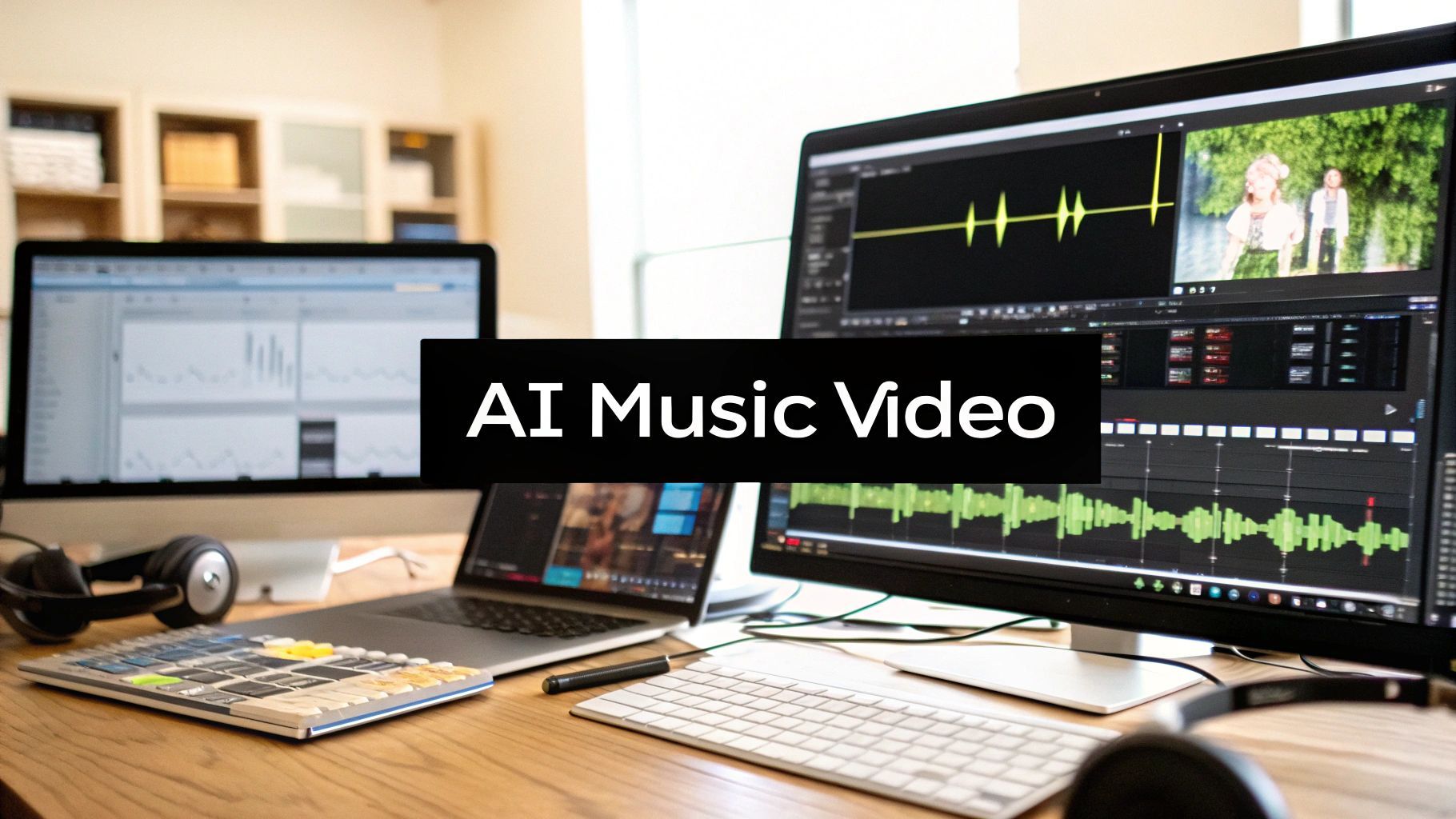


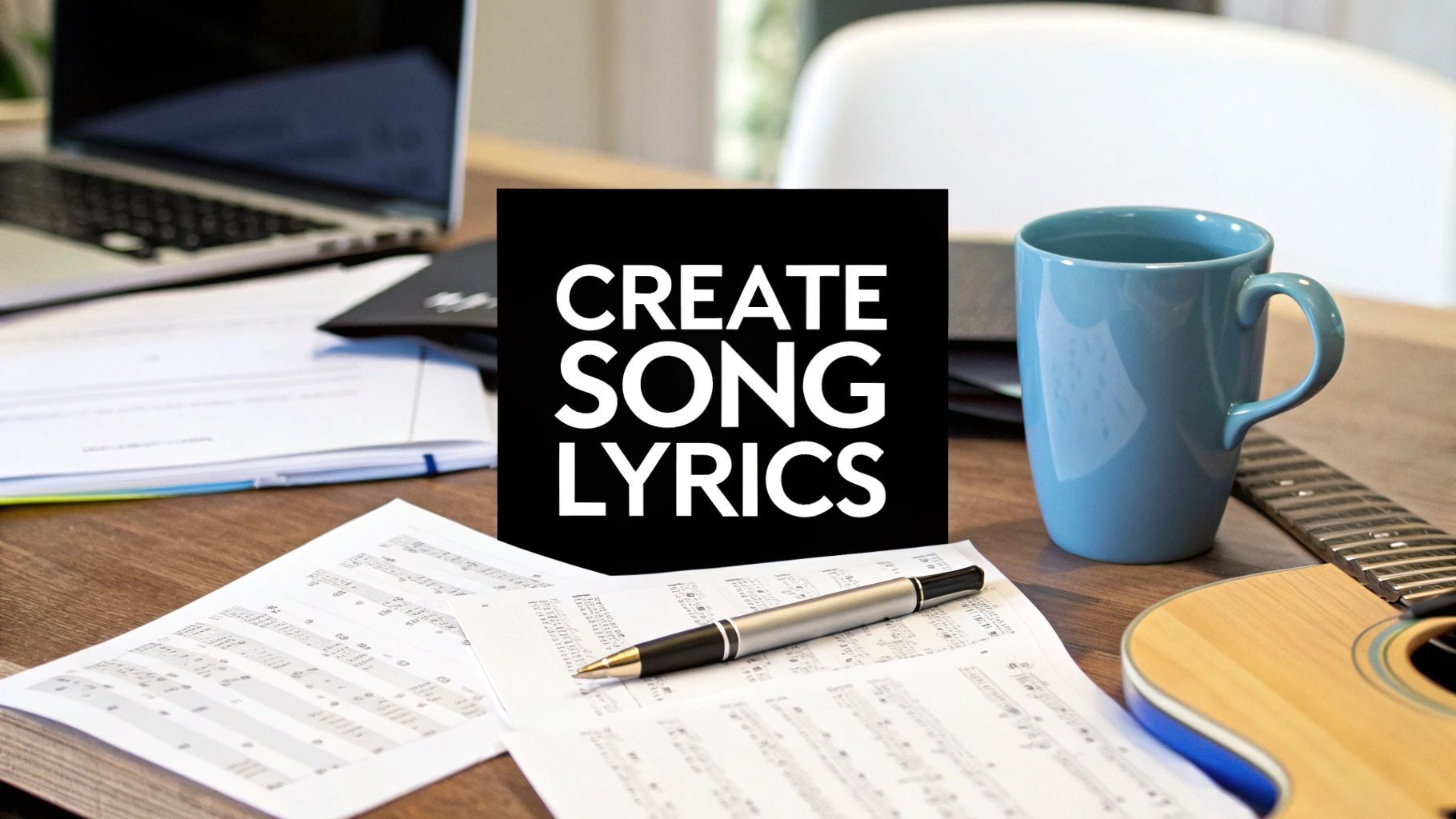
Learn how to create song lyrics with our straightforward guide. Discover practical tips to start writing, structuring, and polishing your lyrics today!
Writing lyrics isn't some mystical art form reserved for the chosen few. It's about taking a real idea, a genuine feeling, and shaping it into an emotional ride for your listener. You’ll brainstorm a theme, sketch out a story, fill it with details people can almost taste and touch, and then—the hard part—edit without mercy.
Think of it less as a magic formula and more about finding a message only you can deliver.
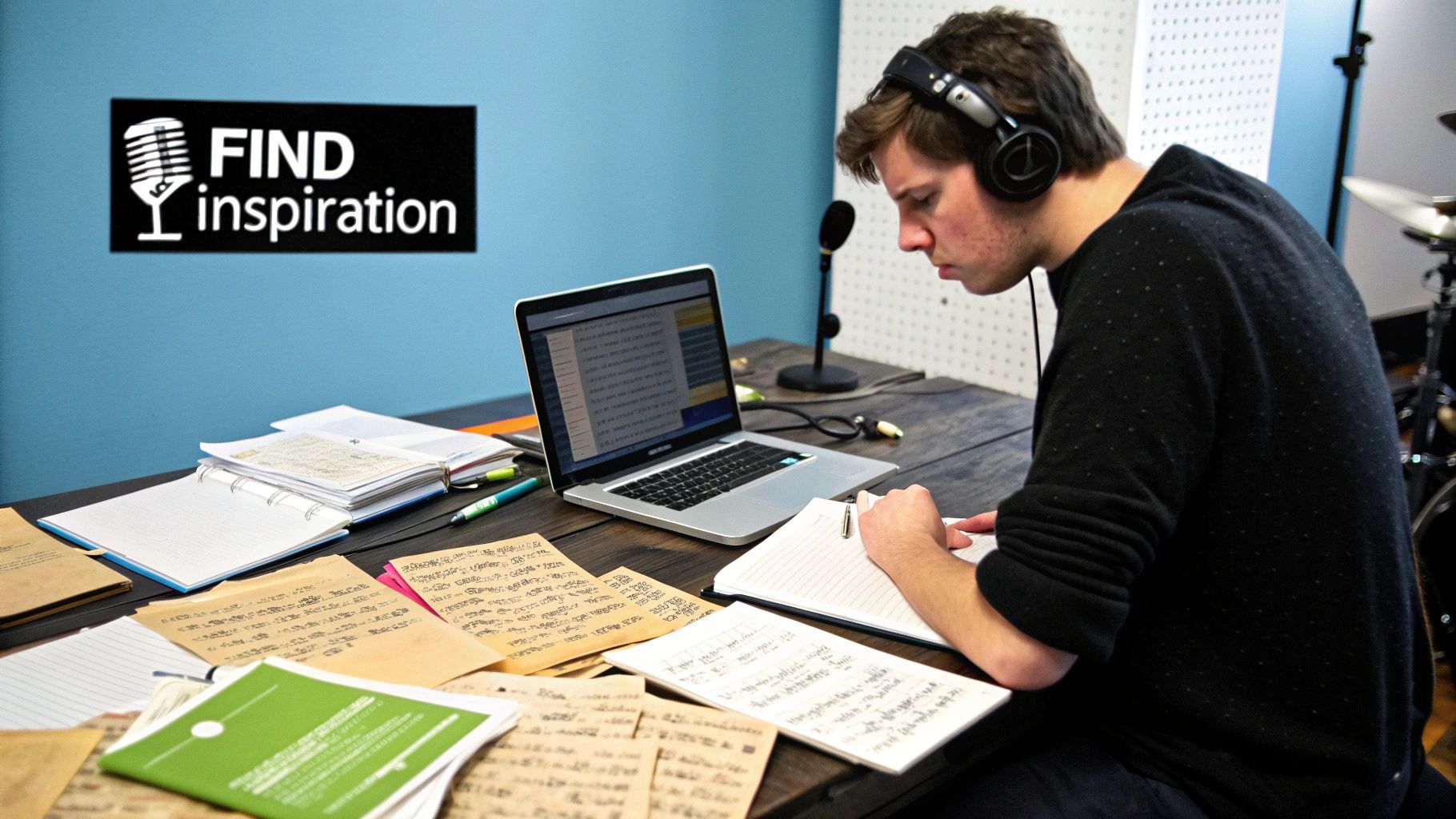
Every great song starts with a spark. An idea that feels both honest and urgent. Forget about rhymes and choruses for a second. Your first job is just to find something that needs to be said. And no, it doesn't have to be some life-shattering epic. The most powerful songs are often born from the small, quiet moments we all experience.
Your unique life—your opinions, your memories, even the things that tick you off—is your greatest songwriting tool. Be a detective of your own experiences and look for the clues that hit you right in the gut.
The most fertile ground for lyrics is your own backyard. Your memories and emotions are a goldmine of raw, authentic material that nobody else has access to. A great first step is simply to reflect on specific moments from your life.
Dig Through Your Journals: Seriously, go look. That one-off line you wrote about a boring Tuesday or a forgotten memory of a first crush could be the entire foundation of a song. Listen to How People Talk: Eavesdrop on yourself and your friends. A weird phrase someone uses, an inside joke, or a snippet from a passionate argument can be the hook you’ve been looking for. Remember the Senses: Go back to a specific memory. What did the air smell like? What song was playing? What were you wearing? Grounding your lyrics in these kinds of concrete details is what makes a personal story feel universal.
Sometimes, the simplest approach is the most effective. If you look at popular music, lyrics have become more direct and personal over the years. Studies have shown a clear trend toward simpler, more repetitive, and emotionally raw language. It proves that listeners crave that unfiltered honesty.
The best song ideas aren't invented; they're uncovered. Stop trying to create a story from scratch and start paying attention to the one you're already living. Your truth is your superpower.
Of course, you can't always just sit around and wait for the muse to show up. A little proactive brainstorming can shake loose ideas you didn't even realize you had. If you’re stuck staring at that dreaded blank page, learning some practical tips for overcoming writer's block can make all the difference.
For a more modern approach when you're truly stuck, an AI lyrics generator can be a fantastic creative partner, offering new angles and helping you break out of a rut.
Here’s a simple exercise to try: grab a piece of paper and write one word in the middle. Something like "home," "regret," or "promise." Now, just free-associate. Write down every single image, feeling, memory, or related word that pops into your head. This little game helps you bypass your inner critic and often reveals the true emotional heart of your next song.
Alright, you’ve got a killer idea. Now what? You can’t just throw a bunch of poetic lines at a page and hope for the best. A great song is a journey, and you're the tour guide. It needs a beginning, a middle, and an end that makes the listener feel something.
Think of song structure as the blueprint for that journey. It’s the emotional map you draw for your audience. Don't sweat it—this isn't about rigid, boring formulas. It's about learning how to build tension, deliver a knockout punch, and then let the listener breathe. Master this, and you’re in complete control of the ride.
Most of the songs you can't get out of your head are built from a few simple, powerful parts. Each one has a specific job to do in telling your story. If you want to write lyrics that truly connect, you have to know what each piece of the puzzle is for.
The Verse: This is where you tell your story. The verses are for setting the scene, introducing the characters, and laying out the details. They’re the "what's happening" parts that give the chorus its real power. The Chorus: Bam! This is the heart and soul of your song. It’s the big, catchy, unforgettable idea you want lodged in everyone's brain for a week. Your main theme lives here. The Bridge: Here’s where you throw a curveball. The bridge offers a new angle, a change of pace, or a different musical flavor. It’s that "aha!" moment or a sudden plot twist right before you bring it all home with the final chorus.
This little breakdown shows you just how popular these fundamental structures are. They're not popular by accident.
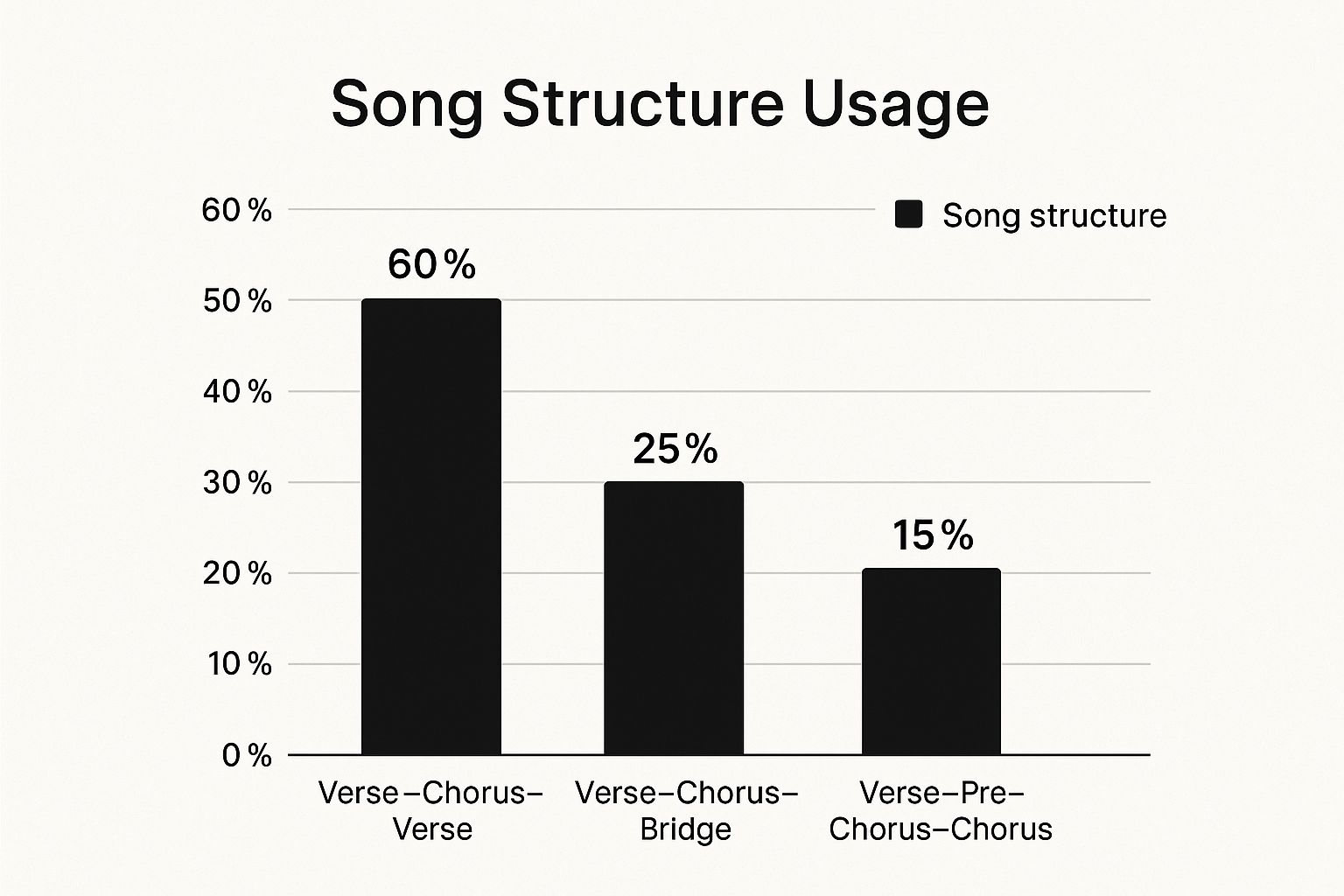
As you can see, a staggering 60% of songs lean on the classic Verse-Chorus-Verse structure. Why? Because it just plain works.
Think about your song structure like a movie plot. Your first verse is Act I—it sets the stage. Take Taylor Swift’s "All Too Well," for instance. The first verse isn't just a vague feeling; it’s a vivid road trip, a forgotten scarf, and a specific memory. It pulls you right in.
Then, the chorus hits with the emotional gut punch: the recurring, universal theme of remembering it "all too well." It’s that beautiful dance between the specific details in the verse and the universal feeling of the chorus that makes the song so devastatingly effective.
To give you a better feel for this, here's a quick cheat sheet on the most common song structures and what each part is designed to do.
| Structure Element | Its Job in the Song | Pro Tip |
|---|---|---|
| Verse | Tells the story, sets the scene, and provides details. | Keep your imagery specific and concrete here. Let the listener see, hear, and feel what you’re describing. |
| Pre-Chorus | Builds tension and anticipation, signaling that the big chorus is coming. | A great pre-chorus often uses rising melodies or a chord progression that feels like it’s leading somewhere important. |
| Chorus | Delivers the main message and the most memorable hook. It's the emotional core. | This should be the simplest, catchiest part of your song. Don't overcomplicate it. |
| Bridge | Offers a change of perspective, a plot twist, or a new emotional insight. | Use the bridge to ask a question, reveal a secret, or look at your theme from a completely new angle. |
| Outro | Wraps things up and gives the listener a sense of closure. | It can be a simple fade-out, a final restatement of the hook, or a reflective musical passage. |
These aren't rigid rules, but they are time-tested tools for taking your listener on a compelling emotional ride.
Your song’s structure isn’t a cage; it’s a launching pad. It provides the tension and release that makes your core message hit a hundred times harder. Use it to guide your listener, build their expectations, and then blow them away.
When you decide to add a bridge, you're essentially adding that "big reveal" moment. It’s when the main character realizes something new, which can completely reframe the meaning of the final chorus. This emotional roadmap is what separates a decent lyric from an unforgettable one. It ensures your big idea isn't just heard—it gets felt.
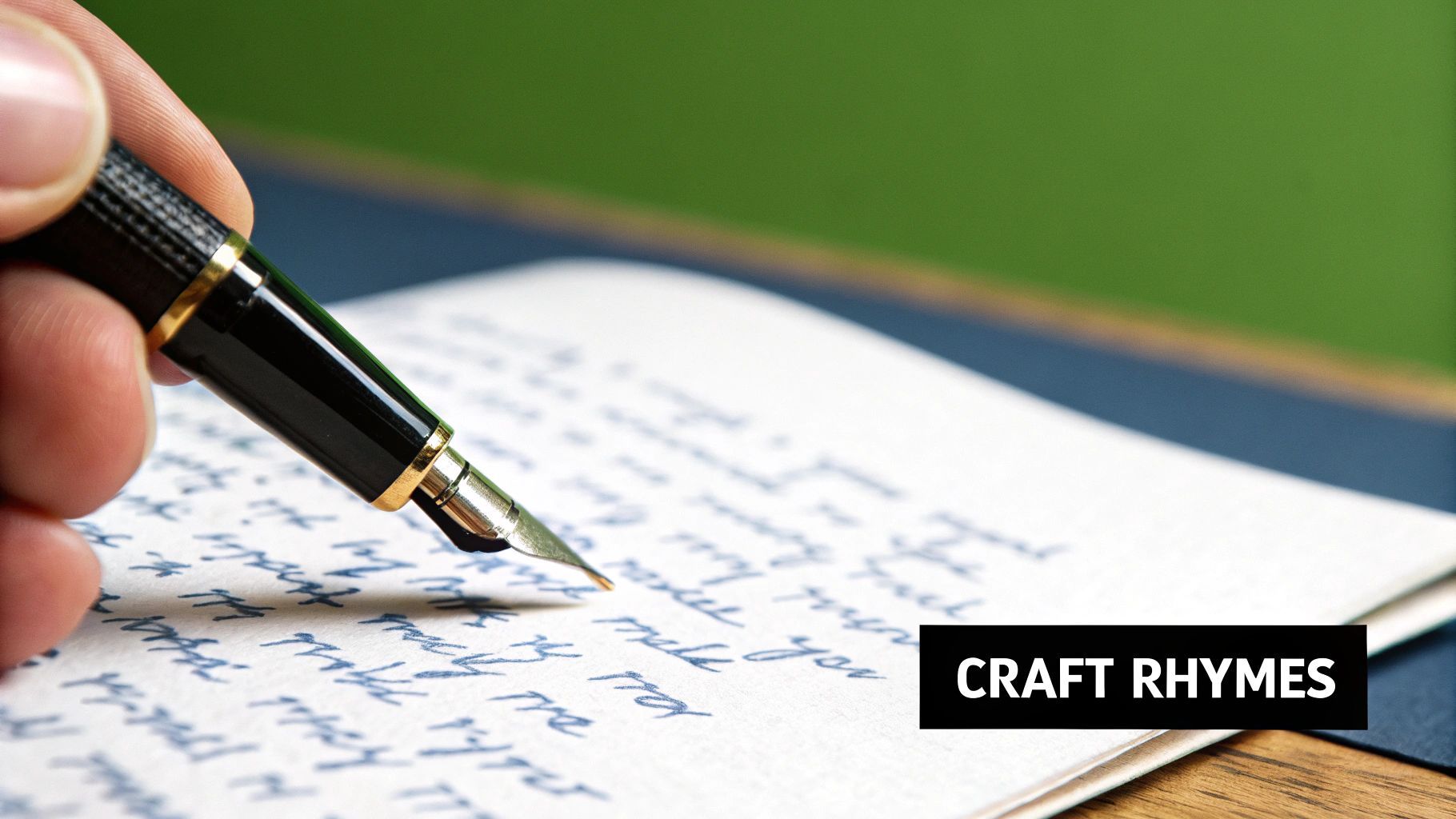
Alright, this is where the real fun begins. You've got your emotional roadmap sketched out, and now it’s time to fill it with words that don't just sit on the page—they practically leap off it, begging to be sung.
Killer lyrics aren't just about stringing together a few clever rhymes. They’re about painting a picture so real, so visceral, that your listener feels like they’re living inside your song. The secret? Ditch the vague, abstract ideas and get down to the nitty-gritty of sensory details.
Instead of just telling us you're sad, show us the "coffee cup rings on the counter" from yesterday morning. Let us hear the "sound of rain on the windowpane" that's been drumming on for hours. Make every single word earn its place.
It's the oldest rule in the writing playbook for a reason: show, don't tell. This single principle is what separates a forgettable, relatable tune from an unforgettable anthem. Your job is to become a camera, capturing the specific, tangible details that unlock a universal feeling.
Think of it like this: "I miss you" is telling. It's a statement. But "I still check my phone for a text that I know isn't coming"? That’s showing. One states a fact, the other makes your listener feel the hollow ache of that empty inbox right along with you.
Your listener can't see what's in your head, but they can see what you put on the screen of their imagination. Use powerful verbs, specific nouns, and sensory language to make your story come to life.
Want to get the hang of it? Try this little exercise:
Write a "Telling" Line: Start with something blunt and boring. "I was angry" or "It was a fun night." Ask "Why?": What exactly made you angry? A slammed door? A specific, cutting phrase someone used? What made the night fun? Engage the Senses: What did that anger feel like? A hot flush in your cheeks? A clenched jaw? What did you see, hear, or even smell in that moment? Rewrite It: Now, turn "I was angry" into something like, "My knuckles went white gripping the steering wheel." See the difference?
Rhyme can be your greatest ally or your most cringe-worthy foe. When it’s done right, it makes your lyrics click into place with a satisfying, musical snap. But when it's forced, it sounds cheesy—like a bad nursery rhyme you can’t un-hear. The golden rule is to never sacrifice your meaning just to land a rhyme.
And please, don't feel chained to those perfect, end-of-the-line rhymes (AABB). That’s just one tool in the box. Play around with different schemes to see how they change the entire vibe of the song.
Internal Rhymes: This is a pro move. Placing rhyming words within the same line adds a slick, subtle musicality that people feel more than they hear. (Think: "The rain in Spain stays mainly on the plain.") Slant Rhymes: These are your secret weapon. Using words with similar but not identical sounds (like "shape" and "keep") feels more modern, more conversational, and a whole lot less predictable.
At the end of the day, the rhythm of your words—the cadence—is often more important than the rhyme itself. Read your lyrics out loud. Seriously. Do they flow off the tongue, or are you stumbling over clunky phrases? If it's awkward for you to say, it’s going to be awkward for someone to sing.
This entire journey of learning https://sendfame.com/blog/how-to-write-a-song is about finding that perfect sweet spot where lyrical poetry meets effortless musical flow.
Here’s something that's easy to forget: you're not writing a poem for a literary journal. You're writing something to be sung, belted out, and echoed back by a crowd. The clarity of your lyrics is absolutely crucial for creating that connection. It's all about singability.
If your fans can't understand what you're saying or can't easily sing along, you're leaving a massive opportunity on the table. It's a wall between you and them.
In fact, recent data shows that providing clear, accurate lyrics can boost fan interaction by a whopping 60%. This isn't just a vanity metric; it proves that people don't just want to passively listen—they want to participate. Writing words that are easy to sing and stick in your head is a direct line to building a passionate, loyal fanbase.
Look, writer's block is a monster. We've all been there, staring at a blank page, feeling like the creative well has completely run dry. But you don't have to battle it alone anymore. Modern AI tools have stormed the scene, acting less like a cheat code and more like a tireless creative partner who never needs a coffee break.
Let's be clear: AI isn't here to steal your soul or write your next hit for you. Think of it as the ultimate brainstorming buddy. It’s fantastic for shattering those moments of paralysis when you can't find a fresh rhyme or a new way to describe a feeling you've written about a thousand times. The goal is to use it as a launchpad, not a crutch.
The trick to working with AI is all in the prompt. Garbage in, garbage out, right? A lazy prompt like "write a sad song" will get you a pile of clichés. You need to feed it the good stuff—specific details, sensory information, and a clear vibe.
Instead of being vague, try something with a little more meat on its bones. For example, a prompt like, "Write a verse about the smell of rain on hot pavement after a fight, but make it sound like a gritty folk ballad," gives the AI something real to work with. It provides context, a mood, and a direction. Suddenly, it’s not just spitting out words; it's a focused creative assistant. For a deeper dive into prompting, check out our guide on how to make music with AI.
Here's what I mean. A simple, well-crafted prompt can give you a goldmine of starting points.
Just look at that. Instantly, you've got concepts like a "Faded Photograph" or an "Empty Swing Set." Each one is a little seed of an idea, a different emotional angle you can run with.
Once the AI spits out a few lines or a verse, your real work begins. This is where the artist takes over. Treat the generated text like raw clay. Maybe you'll love one specific line and build a whole song around it. Maybe you'll twist a phrase until it fits your melody perfectly. Or maybe a suggested rhyme will spark a completely different idea you hadn't even considered.
The magic really happens when you blend AI's brute-force speed with your human soul. Let the machine do the grunt work of finding rhymes and mapping out themes. That frees you up to pour in the heart and emotion that only you can bring to the table.
This hybrid approach is quickly becoming the new normal. In fact, the market for AI-generated song lyrics rocketed to USD 415 million in 2024. Why? Because these tools help artists move faster by offering smart, data-informed suggestions on everything from themes to song structures. You can dig into more stats about the rise of AI in music creation on dataintelo.com.
At the end of the day, AI is just another instrument in your studio. It's a way to break out of your old habits, find new creative pathways, and smash through those frustrating blocks. When you learn to guide these tools, you're not outsourcing your creativity—you're supercharging it.
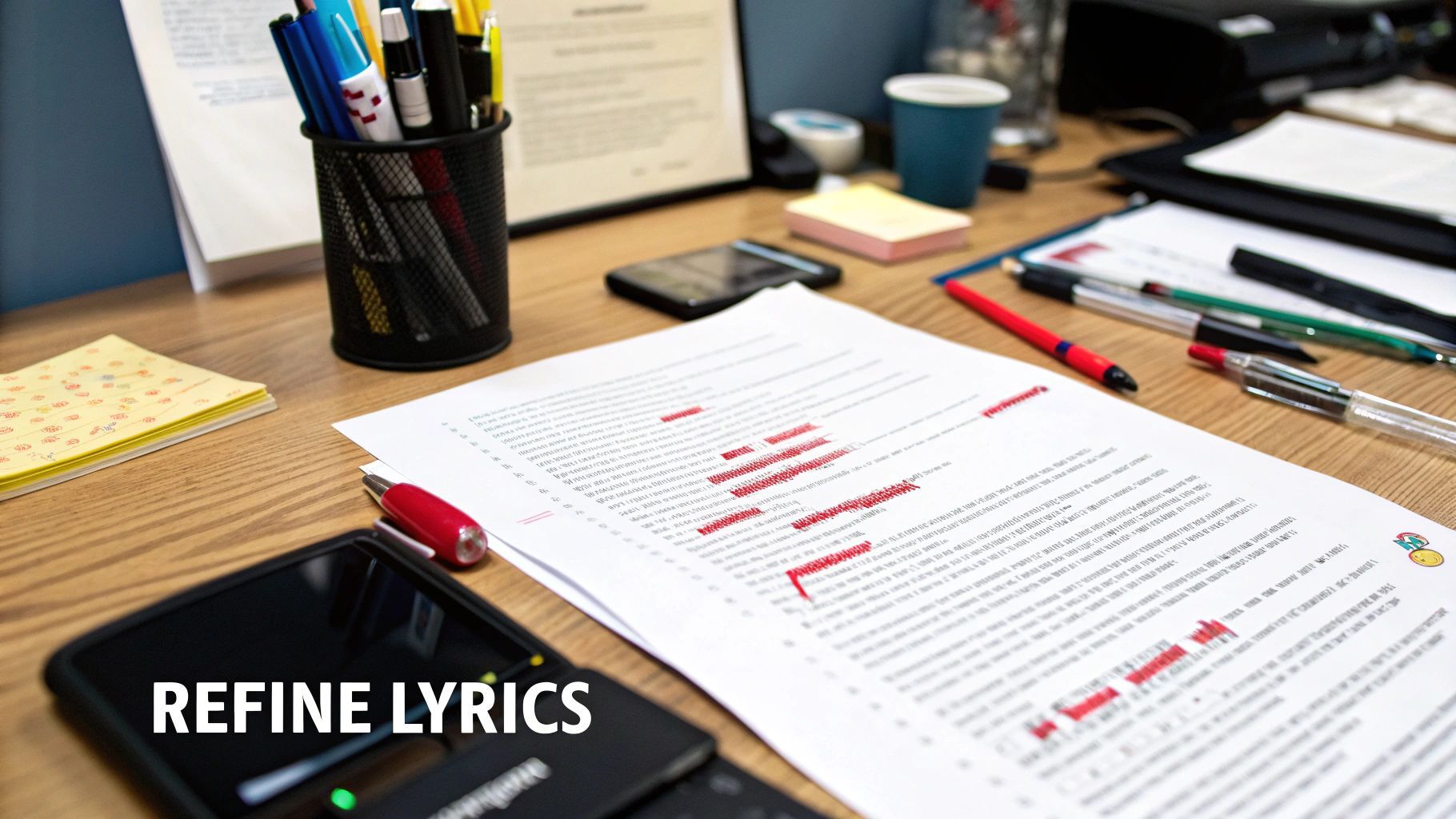
Here's a secret every seasoned songwriter knows by heart: your first draft is never, ever the final product. Think of it as the raw lump of clay. The real magic—the part that transforms a decent idea into an unforgettable song—happens in the rewrite.
This is your chance to put on your editor hat and be absolutely ruthless with your own work. We're not just talking about fixing typos or finding a slightly better rhyme. The goal is to sharpen every single line until it hits with maximum impact. You’ll be cutting anything that doesn't serve the song, punching up weak imagery, and making sure your emotional core is crystal clear from beginning to end.
The very first step to editing is to step away. Seriously. When you’ve just finished pouring your heart into a verse, you’re way too close to see its flaws. Your brain is a fantastic liar; it will fill in the gaps and hear the rhythm you intended, not the clunky one that's actually on the page.
So, put the song away for a day. Or even just a few hours. When you return with fresh eyes, you’ll be shocked at the awkward phrases and cringey rhymes that suddenly pop out. That distance is what lets you switch from passionate creator to objective critic.
A few tricks I've learned to reset my perspective:
Change the Font: It sounds almost too simple to work, but changing the font and size of your lyrics can trick your brain into seeing it as a totally new document. Read It Backwards: Start with the last line and read your way to the top. This completely breaks the flow, forcing you to judge each line on its own merit instead of getting swept up in the story you already know. Print It Out: There's something powerful about holding a physical copy and attacking it with a red pen. It just feels different—and often more effective—than staring at a screen.
Alright, time to put your lyrics through the wringer. The single most powerful editing technique is also the simplest one: read your lyrics out loud. A line that looks perfectly poetic on paper can be an absolute mouthful when spoken.
Listen for the natural rhythm as you read. Does it flow smoothly, or does it feel clunky and forced? Are there spots where you trip over your tongue or gasp for breath? Bingo. Those are the areas that need surgery. This is the audition that separates the good lines from the truly great ones.
Your lyrics aren't a poem meant to live on a page; they're a script for a performance. If a line is awkward to say, it's going to be a nightmare to sing. Trust your ear and your gut on this one.
Every single word in your song needs a job. If it isn't adding to the story, the emotion, or the imagery, it's dead weight. Be merciless. Can you say the same thing in five words instead of eight? Do it. Shorter, punchier lines almost always hit harder.
Finally, swallow your pride and get a second opinion. Play your song for a trusted friend—and make sure it’s someone who will give you an honest take, not just blow smoke. Ask them specific questions like, "What do you think this story is about?" or "Which line, if any, stuck with you?"
Their answers are pure gold. They'll instantly reveal whether your message is landing the way you intended. An outside perspective is one of the most powerful tools you have for polishing that rough draft into a finished piece you can truly be proud of.
Let's be real—the second you decide to write a song, a million questions probably crash into your brain. It happens to everyone. So let's untangle a few of the big ones that always seem to trip people up.
The biggest fear of them all? Not being original. It’s easy to think every idea has been done, every chord progression played. But originality isn't about inventing a new color. It's about taking the colors we all know and painting a picture only you could paint. Your unique voice, your weird memories, your specific way of seeing the world—that’s what makes an old story feel brand new.
Ah, the classic chicken-or-the-egg dilemma of songwriting. And the real answer is… there isn't one. It’s all about what sparks an idea for you on any given day.
Starting with lyrics can help you build a really solid story, where every word pulls its weight. It’s like writing a poem and then giving it a voice.
On the other hand, messing around with a melody or a few chords can set the mood instantly. You might stumble upon a melancholy guitar riff that just feels like a breakup, and suddenly, you know exactly what the song needs to say. Many songwriters find it way easier to slot words into a melody that’s already there.
Don’t get paralyzed trying to find the "right" way to begin. If a killer line pops into your head, chase it. If a catchy riff gets stuck in your ears, build on it. The best method is whichever one actually gets the song out of your head and into the world.
"Good" is tricky because it’s totally subjective. "Effective," however, is not. Effective lyrics make someone feel something. So, instead of asking if your lyrics are good, ask if they’re honest, specific, and clear. Do they paint a vivid picture? Does the chorus land like a gut punch?
Here's a simple trick: the "friend test." Play your song for someone you trust—and don't ask for feedback. Just watch their face. If their eyes wander and they start checking their phone, you might need to punch things up. But if they're nodding along, or better yet, they ask, "Who's that about?"—you've struck gold.
Once you’ve polished your masterpiece, the next step is getting people to hear it. Our guide on how to promote music online is packed with real-world strategies to help you find an audience for your new song. After all, sharing your music is the final, most rewarding part of the whole journey.
Ready to turn those lyrical sparks into a full-blown fire? With SendFame, you can generate entire songs, create incredible visuals to match, and even whip up unique AI celebrity messages to get the word out. Let AI be your co-writer and see what you can create in seconds. Give the tools a spin at https://sendfame.com.
Create Epic
SendFame